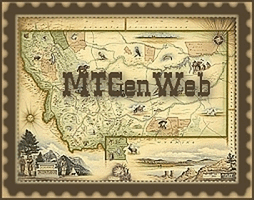

a part of MTGenWeb & The USGenWeb Project

 |
 a part of MTGenWeb & The USGenWeb Project |
 |
| State Coordinaor -
Karen De Groote
| Asst. State Coordinator -
Suzanne
Andrews County Coordinator - Denise Wells |
| Home |
African Americans |
Archives
| Bibliography |
Biographies |
Cemeteries
| Census |
Cities | History
| Land Records |
Libraries Lookups | Maps | Military | Miscellaneous | Native Americans | Vital Records | Volunteer | What's New? HISTORY |
| Madison County. Madison county is one of the counties of the southern group. The Madison range forms its eastern boundary, the Tobacco Root and Snow Crest ranges rise in the central portion and the Ruby mountains in the west of the county. It is watered by the Madison, Jefferson, Ruby, Beaverhead and Big Hole rivers and their tributaries. These streams have extensive and fertile valleys where the soil is rich and agriculture flourishes. Historically speaking, Madison county is peculiarly interesting. Within its boundaries is the famous Alder gulch, discovered in 1863, which has produced more gold than any similar area in the world, and is still unexhausted. The days of placer mining are gone. Instead, at the mouth of the gulch we find large dredges which handle profitably great quantities of gold-bearing dirt. Quartz mining followed placer mining, and Madison has produced more gold than any other county in the state. Frequently it leads in the monthly reports of gold production. The greater part of the county is a mineralized region and numerous mining camps exist. Silver Star, Iron Rod, Twin Bridges, Rochester, Sheridan, Virginia City, Pony, Norris and Red Bluff are towns that are surrounded by rich mines. In addition to gold, silver, copper and lead are ores of tungsten, iron and manganese, pure limestone and coal. Sapphires and rubies are found in placer diggings. In the numerous mining districts are many good opportunities for the prospector, miner and the capitalist. An immense quantity of hydro-electric power is available, part of which is being utilized by the Madison River Power Company, which has built a dam across the Madison river seven miles from Norris and established a large plant that generates twenty thousand horse power the year round. The power is transmitted to several points in the county, and also to Butte and Anaconda on the west; to Bozeman, Livingston, Billings, and other places on the east. At the Upper Madison canon the same company has built an immense dam and will harness a great power besides .storing large quantities of water for irrigating purposes. Mining, stock raising and farming are the three leading industries. Some of the best-bred horses, cattle and sheep in the United States are raised in this county. King Brook, a horse born in the Ruby valley, established, in 1911, a trotting record for the Pacific coast. Fine herds of cattle are numerous, and much attention has been paid to improving the breeds of sheep. Horses, cattle and sheep are shipped in large numbers each year and sell at prices that prove their quality. The most important agricultural districts are in the valleys between the ranges. The Jefferson valley extends from the northern boundary to Twin Bridges, where the river is formed and embraces in its own drainage basin and those of the South Boulder and Willow creek a great extent of excellent farm land. South of Twin Bridges are the Beaverhead and Ruby valleys, the former about fifteen miles long and five miles wide, and the latter which is about thirty miles long and three wide. The extensive areas in these valleys contain many highly improved and productive farms. The trading points are Waterloo, Twin Bridges, Sheridan, Laurin and Alder. A part of the Willow Creek valley is in Gallatin county, but the upper part is in Madison county and extends to Pony and Norris. South of Norris is the Madison valley, about thirty-six miles long, including bench lands about five miles wide. Development as a farming region has been delayed by the lack of railroads. Large crops of oats, wheat and hay are raised. Meadow Creek, McAlister, Ennis, Jetters, Cameron and Lyon are postoffices in this valley, which has room for at least five times its present agricultural population. Many excellent ranches are in this section. In the valleys are irrigated lands, and on the benches farming without irrigation has proved successful. Several projects are pending that will increase the acreage of irrigated land and some of the large ranches are being subdivided and sold in farm lots. The principal crops are wheat, oats and hay. The soil through the county is fertile and large yields are the rule. Crop reports have been gathered this year from many farmers in different sections; fifty bushels of wheat, eighty bushels of oats, three and four tons of alfalfa are not rare yields. A few yields even greater are reported. An oat crop at Alder yielded an average of 107 bushels to the acre; Laurin produced sixty bushels of barley per acre ; and in the Madison valley the wheat threshed an average of 71 bushels to the acre. The average of the large acreage reported is very high for all crops. Potatoes are extensively grown and make large yields. A farmer of Waterloo had 35 acres in potatoes and the yield was 250 bushels to the acre. He exhibited 13 varieties of potatoes at the Montana State Fair and was awarded the Hill trophy for the best exhibit of ten varieties or more; and at the St. Paul Land Show he won the cup for the “best individual display of potatoes.” Excellent strawberries are grown and are a profitable crop. Many orchards have been set out in the past few years and Madison county promises to become an important producer of apples. The county is sparsely settled and offers unusual advantages to the homeseeker. The markets of Butte and Anaconda are convenient and fruits, dairy products, eggs and chickens are always in demand. Although the county has no town of more than one thousand population, there are two newspapers at Virginia City, and Sheridan, Twin Bridges and Pony each has one. The principal places are Virginia City, the county seat, an important commercial and mining center, a rich town and of great historic interest, having been the territorial capital; Pony, a mining town and trading point for the Willow Creek country; Sheridan, a pretty and thriving town, surrounded by rich farm lands and near producing mines; and Twin Bridges, which is situated at the head of the Jefferson valley near the confluence of the Ruby, Beaverhead and Big Hole rivers and at the outlet of the valleys of those rivers. Twin Bridges possesses a favorable location for growth in size and business importance and undoubtedly has a bright future before it. At the Madison county fair, which is held every September at Twin Bridges, many excellent products are displayed and some are sent to the State Fair, where Madison county always wins a number of prizes. The State Orphans’ Home is at Twin Bridges and occupies buildings that have been erected at a cost of $110,000. It has numerous inmates and is well supported by appropriations for its maintenance. The Northern Pacific has a branch line extending from Whitehall to Alder and another from Sappington to Pony and Norris. An electric line from Alder to Virginia City is contemplated. The extension of the Pittsburg & Gilmore Railroad from Dillon to Twin Bridges and Whitehall is a probability of the near future. The construction of a road in the Afadison valley would open up a very extensive section. 'I'he unappropriated and unreserved public lands in Madison county in 1908 were 1,527,412 acres, and 1,197,152 in 1911. The population was 7,695 in 1900 and 7,229 in 1910. In 1911 the Centennial valley, a large district, was taken from Madison and put into Beaverhead county. The assessed valuations in 1908 were $6,309,319, and $6,431,426 in 1911. Source: Sanders, Helen Fitzgerald, A History of Montana © 1913; Chicago: Lewis Publishing Co.; pgs. 716-718 |
| © Madison County, MTGenWeb 2006 - current date | Last updated September 2022 USGenWeb | MTGenWeb |